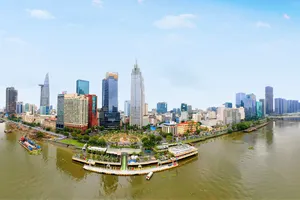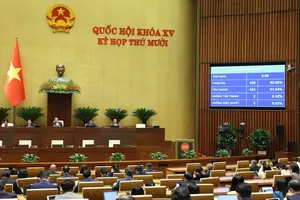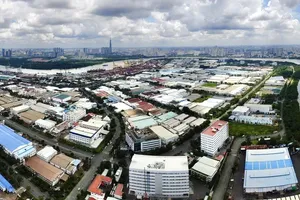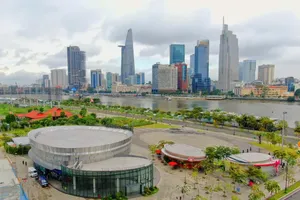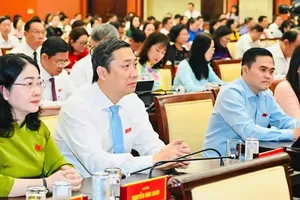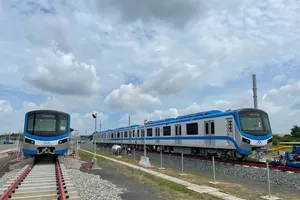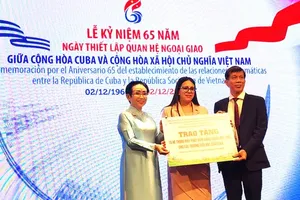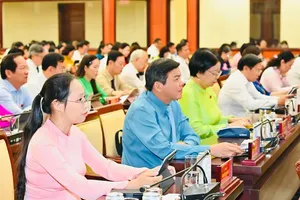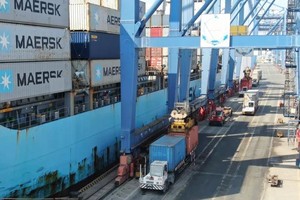
Re-establishing order on curbs and sidewalks has been a major policy objective for HCMC for many years, integral to its aspiration of becoming a civilized, modern, and compassionate city. Alongside significant investments in infrastructure upgrades and sidewalk renovations, local authorities demarcated pedestrian pathways with painted lines.
In early 2024, districts 1, 3, 4, 8, and 10, among others, began implementing Decision No. 32/2023/QD-UBND (dated July 26, 2023) of the HCMC People’s Committee. This decision pertained to the management and temporary use of parts of roadways and sidewalks, authorizing the collection of sidewalk usage fees to generate revenue for the management, maintenance, and utilization of these public spaces.
Residents initially saw HCMC sidewalks become more accessible with fee collection, especially in central streets like Hai Ba Trung and Le Loi, which grew tidier. However, this program was suspended to align with Government Decree 165/2024/ND-CP (Road Law).
Consequently, due to a lack of a consistent management model and inadequate supervision, many previously cleared sidewalks have become cluttered again. Once model streets for “clear roads, open sidewalks”, Hai Ba Trung Street and Nguyen Trai Street are now plagued by disorder, with haphazardly parked motorbikes and rampant goods displays leaving minimal pedestrian space. This highlights the challenge of maintaining urban order without sustained, effective management strategies.
In HCMC districts yet to implement sidewalk fee collection under Decision 32, the situation is often more chaotic. “Hotspots” of illegal encroachment for commerce and motorbike parking plague streets like Xo Viet Nghe Tinh (Binh Thanh District), Pham Van Bach (Tan Binh District), and Duong Quang Ham (Go Vap District).
Go Vap resident Phan Xuan Hai lamented that the recently upgraded Duong Quang Ham Street, initially popular for exercise, is now overrun every afternoon. Vendors from nearby residential areas deploy carts and furniture, completely covering sidewalks for hundreds of meters. This leaves absolutely no space for pedestrians, illustrating the severe impact of unchecked encroachment on public spaces.
The restoration of order on streets and sidewalks is an urgent prerequisite for building a civilized, modern city. Yet, while the sidewalk fee policy is on hold, traditional measures such as public awareness campaigns, confiscation of trading paraphernalia, and administrative fines appear to lack sufficient deterrent effect.
Vice Chairman Doan Van Du of the Tan Binh District People’s Committee detailed efforts against encroachment on Pham Van Bach Street. Authorities conducted awareness campaigns and issued business reminders.
The ward’s urban order team, with other forces, regularly launched clearing operations, seizing items like umbrellas, signboards, and homemade carts. Warnings were issued to 60 businesses, and administrative fines of VND50 million (US$1,965) were imposed in 20 cases.
However, the Vice Chairman acknowledged that despite these concerted actions, illegal trading and encroachment activities unfortunately tend to resurface quickly, highlighting the persistent challenge of maintaining long-term sidewalk order.
On Nguyen Gia Tri Street in Ward 25 of Binh Thanh District, efforts against sidewalk encroachment prove frustratingly short-lived, likened to “throwing a stone into a duckweed-covered pond” as order quickly reverts.
An initial enforcement campaign (Feb 24 - Mar 7, 2025) saw 43 violation notices, VND80 million ($3,143) in fines, and confiscation of 39 carts, 54 signboards, and 773 tables and chairs. Despite this, encroachment persisted. A subsequent campaign (Mar 8 - Mar 19) yielded 13 more notices, VND16.9 million ($664) in fines, and further seizures of signboards and furniture.
Frustrated residents report that sidewalks are only clear during student summer breaks, with encroachment predictably returning once the school year begins, highlighting the challenge of sustained order.
An official from the Binh Thanh District People’s Committee acknowledged that while some streets have shown improvement, a lack of sustained inspection allows encroachment to recur. A current challenge in restoring order is the difficulty in penalizing street vendors using carts, particularly if they are migrants or facing economic hardship. These vendors often accept the confiscation of their goods and equipment (which are typically of low value). Some individuals even resist authorities during inspections and attempts to seize infringing items.
Inter-agency coordination for inspections and restoring urban order remains suboptimal, especially concerning streets that border multiple wards or districts. Furthermore, some fined individuals do not comply with payment, and authorities often lack information on violators’ bank accounts or employers, further complicating fine collection.

